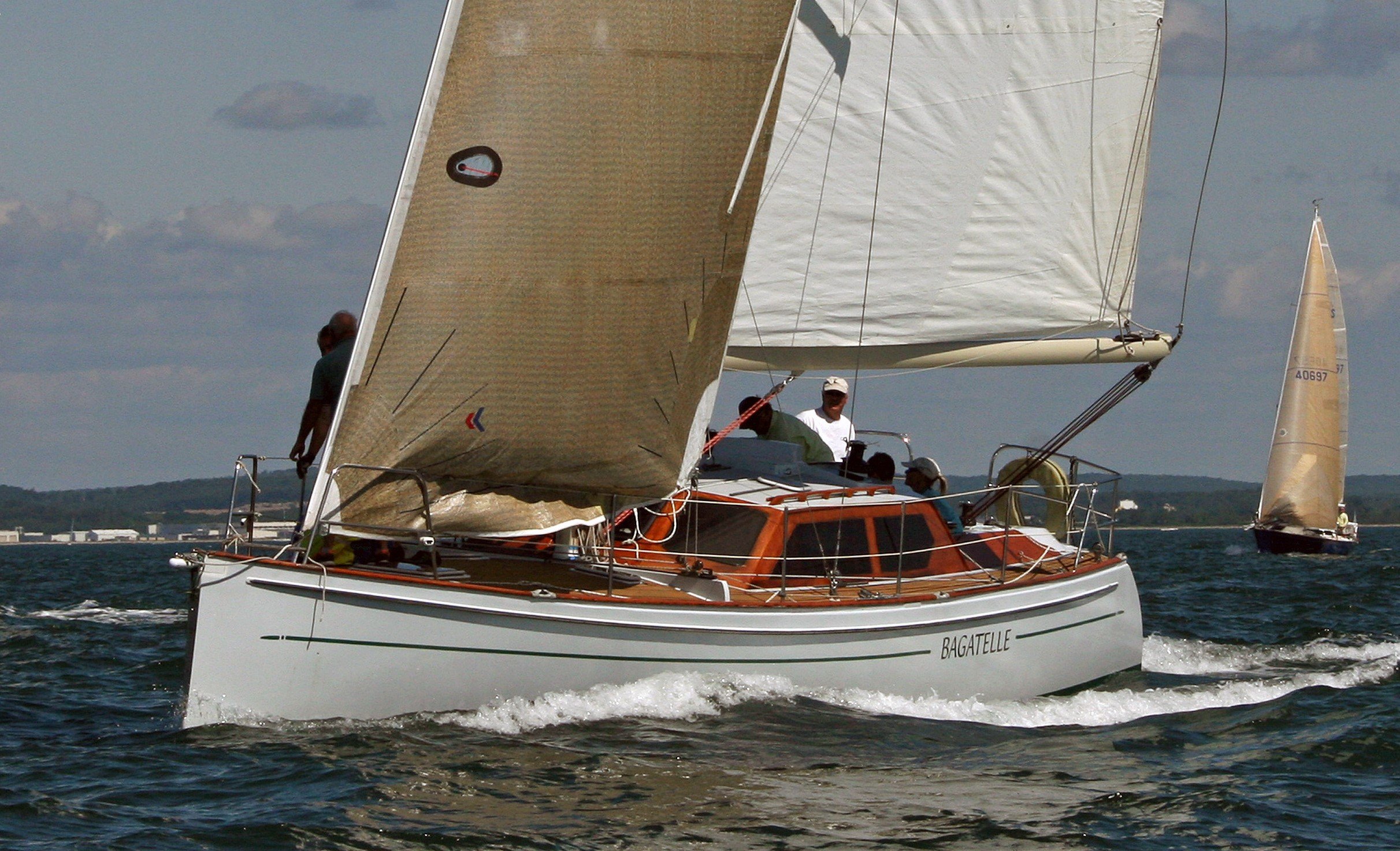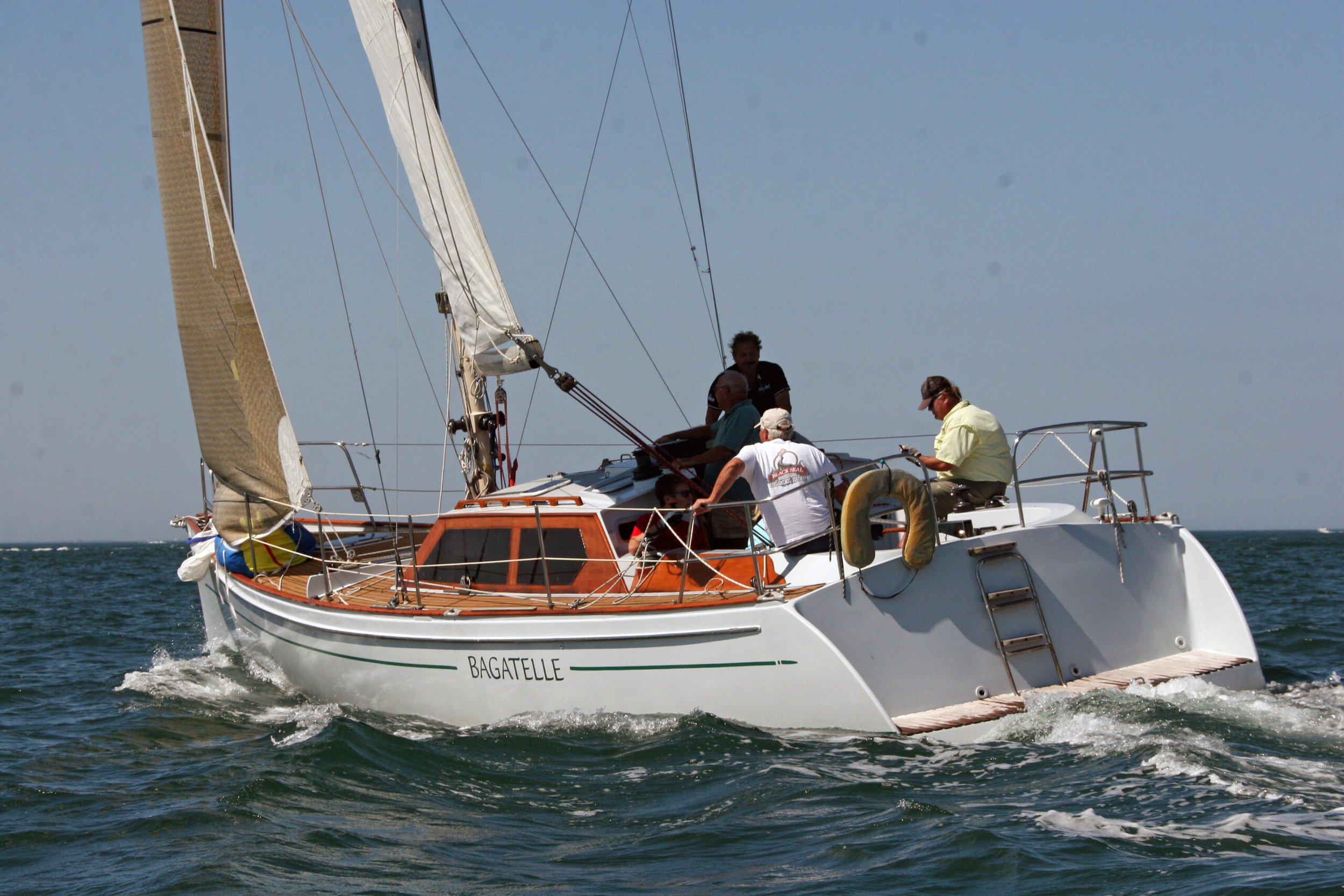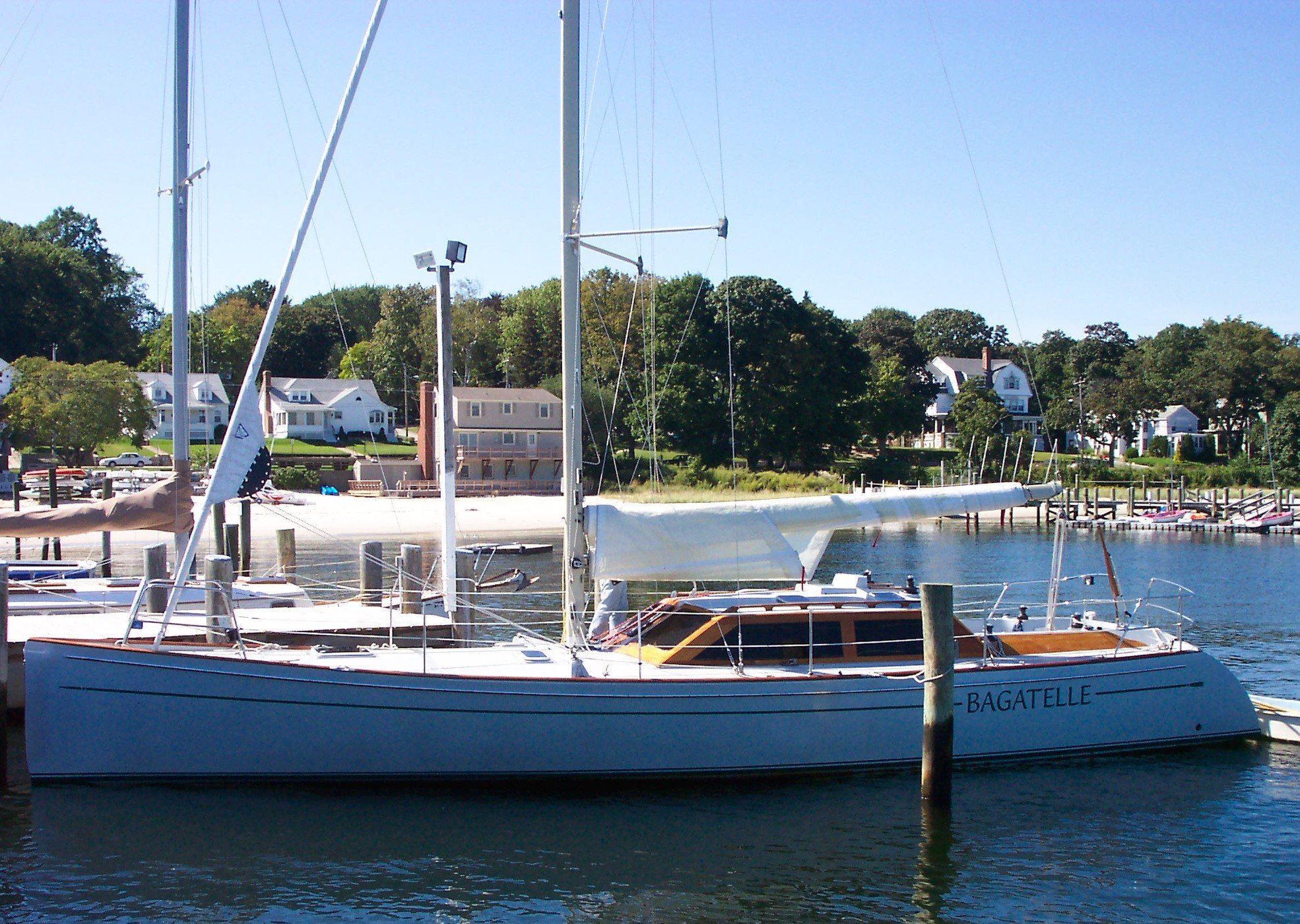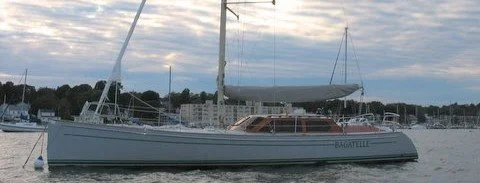Bagatelle
2000, Custom Sponberg / Waters Fast Sloop, 44’

































Bagatelle - New Asking Price of $50,000
Interior Layout and Accommodations
Bagatelle has an interior well suited to the boats purpose of being an easy to sail day boat but also a fast race boat with
enough in the way of accommodations to house and feed the racing crew in relative comfort either at the end of a
coastal day race or overnight for longer more offshore events.
All the necessities for guests or the on-deck watch (head, galley and navigation station) are located within easy reach to
port and starboard of the companionway.
Further forward is the main saloon with settee seating / berthing to port and starboard and a drop leaf table on
centerline. If needed there is an additional berth that can be set-up above and slightly outboard of the port settee.
There are two more pipe berths in the forward cabin that also is used for headsail and spinnaker storage during racing.
Hull and Deck Construction
Light weight displacement hull with fin / bulb type keel and balanced spade rudder.
Keel is comprised of stainless-steel fin with lead ballast bulb, stainless steel trim tab and internal dagger board for
improved upwind performance.
Rudder is of carbon fiber construction with carbon fiber rudder stock.
Hull is of cold-molded, wood-epoxy construction strip planked with 5/8" tongue and grove western red cedar and 2-
layers of 1/8” Spanish Cedar laid over Mahogany ring frames spaced on 4’ centers.
Hull exterior is sheathed in 1-layer of 10 oz. fiberglass cloth set in epoxy and finished with an Awlgrip paint outer
surface.
Hull interior is sealed in epoxy.
Decks and superstructure are constructed of a sandwich construction of marine plywood with Corecell foam core
material. Exterior deck is sheathed in 1-layer of 10 oz. fiberglass cloth set in epoxy.
Deck and super structure areas are finished with an Awlgrip finish outer surface over-laid with faux teak decking on the
side and forward decks along with natural teak non-skid strips on the cockpit seating and underfoot in the cockpit and
on swim platform / transom.
An interior wooden I-beam runs the length of the boat providing an attachment point for all ring frames, stringers and
floors with all of the above mentioned sealed in epoxy.
The deckhouse and cockpit are a foam cored fiberglass fabrication thru bolted to the deck carlins. The deck house has an
overlay of 1/4"mahogany, finished bright. The deck house windows are polycarbonate except for the forward center
which is a 24" Lewmar opening hatch.
Water Ballast System
Water ballast tanks are installed under the side decks outboard.
Tanks are connected by large diameter PVC piping.
High-capacity pump quickly moves water ballast from side to side.
A high-capacity electric pump fills the ballast tank on starboard tack and gravity moves the water to the other side just
before the tack. This process takes 20 seconds. The ballast tank is emptied while on starboard tack by gravity or high-
capacity electric pump.
Hull and Deck Finishes
Topsides are an Awlgrip finish
Topsides are Aqua Mist White
Boot and Cove Stripes are Forest Green
Decks, cockpit and house superstructure are Aqua Mist White
Cabin sides and cockpit comings are varnished Mahogany
Bottom is coated with a very smooth coat of Black Widow anti-fouling paint.
Deck, Cockpit and Cabin Top Hardware and Features
Stainless steel bow rail
Stainless steel life line stanchions
Double coated wire life lines port and starboard
Toe rails / bulwarks running full length port and starboard with varnished Mahogany cap rails
Bow cleats port an starboard
Self-bailing anchor / ground tackle locker forward
Lewmar opening hatches (3ea.) on foredeck
Self-tacking jib sheet traveler
Bronze mast partners
Stainless steel mast partners
Lewmar opening hatch / window on forward face of cabin house
Lewmar opening hatches (4ea) on cabin top
Stainless steek chainplates port and starboard
Sail tracks on tops of cap rail, inboard side decks and cabin top ( 20, 15, 10 degree sheeting angle for close reaching code
zero) Additional sail track further aft on cap rail for regular code zero
Varnished Mahogany handrails on cabin top port and starboard
Companionway hatch with varnished Mahogany trim
Large storage lockers in cockpit
Stainless steel stern quarter rails with gate opening aft
Stainless steel boarding / swim ladder with teak treads
Spars and Rigging
Fractionally rigged, triple spreader sloop configuration
Bergstrom Rigging design with highly swept-spreader angles and diamond stays
Forte Carbon carbon fiber mast painted Tan Awlgrip
Navtec stainless steel rod standing rigging with stainless steel turnbuckle adjusters
Mast fitted with Antal main sail track
Composite Engineering aluminum boom painted Tan AwlGrip
Bagatelle is an Eric Sponberg designed, Rick Waters built cold-molded, wood-epoxy constructed fast daysailer/racer with an on-deck arrangement and accommodations below to allow for lots of friends and family along for an afternoon's romp, berthing space for the racing crew or a comfortable weekend (or longer) cruise.
The Eric Sponberg design of Bagatelle (French for “a trifle”) was commissioned in 1997 and after construction she was launched in the summer of 2001. An avid racer, her owner wanted a lightweight boat that could plane in under 20 knots of wind, point really well and sail fast upwind, yet still look like it belongs in good company sitting next to a Concordia yawl—in his words, “a modern classic.” Specific features include: very lightweight construction (Douglas fir veneers over western red cedar strip-planking); chined hull form in the stern sections for planing; lifting keel for easy trailerability; B&R rig (no backstay, triple spreaders) for high lift, large sail area, and high speed; and water ballast.
Bagatelle’s hull is partially chined with wide, flat after sections and very narrow bow sections. The chine is very pronounced back aft and blends into the bow and disappears forward of the keel. Bagatelle has standing headroom under the coach roof and sitting headroom forward of that. The design draws lots of compliments from the public, in part from its long, sleek look but also from its performance on the water and racecourse either cruising, day sailing or racing.
Price: $50,000
Location: Southeastern Connecticut
Sails and Canvas
Main Sail 1: Farrar Sailmakers Diax laminate with taffeta on both sides, extreme square head, full battens, one reef, 5
years
Main Sail 2:Jasper & Bailey, Woven Spectra, small square head, full battens 2 reefs, 10 years old but not used in the last
5 years
Jib 1: Farrar Sailmakers DPI Carbon GP with lite skin 2 years
Jib 2: Farrrar Sailmakers Carbon/kevlar laminate, vertical battens, 7 years
Jib 3: Jasper & Bailey Dacron jib, 10 years
Code Zero 1: North stormlite, 20 years old
Code Zero 2:Farrar polymax. 4 years old, white, extremely close winded
Code One 1:North polyester, white, 20 years old, close winded reaching spinnaker
Code One 2: Farrar Sailmakers polyester, 5 years, deep runner
Code Two 1: Farrar Sailmkers nylon, green and gray, 5 years
Fractional AP Spinnaker: Jasper & Bailey, polyester, 18 years old, little use
Sail Trim and Sail Handling Equipment
Profurl roller furling headstay
Lewmar self-tacking jib track / traveler
Lewmar headsail sheet tracks on bulwarks, side decks and cabin top
Lewmar mainsheet traveler
Lewmar rope vang
All adjustable cars, fixed and moving blocks by Lewmar
Boom rigged for double reefing
All winches by Harken
Harken #16 (3 each) at mast for halyards and reefing
Harken #40 2-speed, self-tailing in cockpit (2each)
Harken # 32 2-speed, self-tailing in cockpit (2each)
Harken # 42 2-speed self-tailing in cockpit (1each)
Harken #44 Electric 2-speed, self-tailing in cockpit (1each)
Auxiliary Propulsion and Fuel Systems
Engine: Yanmar, 3GM30F, 3-cylinder, 30HP diesel
Saildrive SD-20 drive unit with 3-bladed Max-prop
Yanmar ignition panel with tachometer and engine status gauges
Single lever throttle and transmission control lever
Flexible exhaust hose with Vetus water-lift type muffler and vented loop
12 Gallon polyethylene fuel tank
Yamaha fuel / water separator type primary fuel filter
Fuel shut-off at primary fuel filter
Steering System
Balanced spade carbon fiber rudder with carbon fiber rudder stock
Harken rudder bearing
Tiller steering
Keel trim-tab for increased upwind performance
Electrical Systems
12-Volt system
Separate battery banks for engine start and house electrical systems
House Batteries: Group 24 wet cell batteries (2ea) in sealed battery containment box
Starting Battery: Group 24 wet cell battery (1ea) in sealed containment box
Paneltronics 12 Volt dc panel with main service switch, voltage gauge and 12 individual circuits
Heart Interface battery monitor
Battery charging by engine alternator
Plumbing and Sanitation Systems
25 Gallon freshwater capacity
Bladder type tank located under port settee
Manually (foot pump) supplied cold water only
Sink basins in galley and head
Lavac manually operated marine toilet / MSD
MSD plumbed by means of Y-valve for direct overboard discharge or discharge to holding tank
10 Gallon holding tank
Holding tank plumbed by mean of y-valve for discharge to shore-side pump-out facility or pumped overboard when
offshore at proper distances.
Electronics and Navigational Equipment
Ritchie 4” helm compasses (2each)
Nexus Multi GPS / Chartplotter
Nexus Multi sailing instruments with multi-function displays at companionway, aft cabin bulkhead and helm stations
Standard Horizon VHF radio with DSC
Sony tuner / CD player.
Ground Tackle Equipment
36 lb. Bruce anchor with appropriate chain and rode
Fluke anchor with appropriate chain and rode.
Dewatering Equipment
All bilge pumps manual and auto
Safety and Required Equipment
Marpol and Oil Discharge placards
Handheld horn
Type III PFD’s (5 each)
Type IV throwable PFD’s (4ea)
Life ring (1 each)
Additional Equipment
Spare Composite Engineering carbon fiber mast painted Tan AwlGrip

